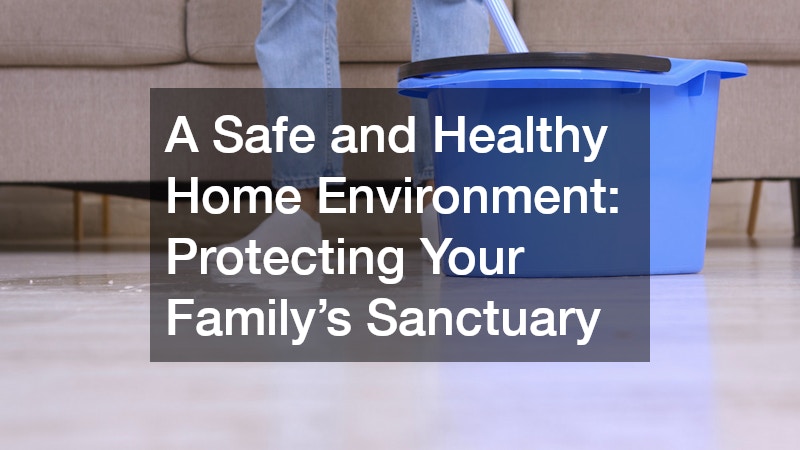What does it truly take to create a happy and healthy family in today’s fast-paced, unpredictable world? For many households, family wellness is no longer just about eating balanced meals or staying active. It’s about nurturing a safe, supportive, and thriving environment where every member—young and old—can flourish physically, emotionally, and mentally.
Modern families are recognizing that good health starts at home. It’s in the air we breathe, the relationships we build, the choices we make, and the professionals we trust to keep our loved ones safe and well. From doctors and dentists to home service providers and mental health professionals, family wellness is a shared effort that blends care, prevention, and community support.
Building a happy and healthy family requires more than one approach—it’s about harmony across all aspects of life. This guide explores how you can achieve whole-home wellness by nurturing your body, mind, and living space.
Nurturing Physical Health: The Foundation of Family Wellness
Physical health is often the first thing that comes to mind when we think of family wellness. It’s the foundation upon which all other forms of well-being are built. Maintaining regular medical care ensures that every family member—from toddlers to grandparents—receives the attention they need to stay strong and resilient.
When unexpected fevers, sprains, or infections occur, families rely on pediatric urgent care facilities to get fast, reliable treatment for their children. These centers bridge the gap between a pediatrician’s office and the emergency room, providing after-hours care and convenience that parents can count on. Regular medical visits ensure that minor issues are treated early, preventing more serious health concerns later on.
Dental health plays an equally important role. Regular appointments with a family dentist help prevent cavities, gum disease, and other oral problems that can affect overall health. Studies have shown that oral infections can contribute to heart disease and other systemic issues, so consistent dental care is not just about a bright smile—it’s about protecting your entire body.
A physically healthy family also prioritizes preventive care. Annual checkups, vaccinations, and screenings are vital in catching potential issues before they escalate. When these habits are established early, they set a strong example for children and teach them the importance of lifelong health responsibility.
Being proactive about physical health provides families with a sense of control and security. Knowing that you can rely on skilled professionals—whether it’s your pediatrician or family dentist—gives you peace of mind that your loved ones are protected.
Supporting Wellness Through Alternative and Preventive Care

Traditional medicine remains essential, but many families today are turning to complementary and holistic approaches to round out their wellness routines. Integrating alternative and preventive care into daily life can boost energy, reduce stress, and enhance quality of life.
For instance, chiropractors offer a non-invasive way to address body pain, posture issues, and spinal alignment. Regular chiropractic adjustments can relieve back or neck discomfort, improve mobility, and even enhance sleep quality. For families with active children or adults with desk jobs, chiropractic care can make a huge difference in maintaining physical comfort and long-term musculoskeletal health.
At the same time, alternative medicine practices—such as acupuncture, herbal therapy, and mindfulness techniques—are gaining popularity. These methods focus on treating the body and mind as interconnected systems rather than isolating symptoms. While they shouldn’t replace conventional treatment, they can complement it beautifully by promoting relaxation, reducing anxiety, and enhancing immune function.
Families embracing holistic care often find that these methods encourage self-awareness and balance. Taking time to meditate, stretch, or use natural remedies (under professional guidance) fosters a calmer, more centered home atmosphere. The key is to maintain a healthy balance—consult licensed practitioners, communicate openly with your healthcare providers, and ensure every approach aligns with your family’s needs.
Preventive care isn’t just about avoiding illness—it’s about promoting vitality. Whether through regular chiropractic visits or exploring safe forms of alternative medicine, families can take active steps toward maintaining energy, reducing stress, and feeling their best year-round.
Emotional and Relationship Health: Strengthening Bonds at Home
A healthy body means little without a healthy heart and mind. Emotional and relationship wellness are cornerstones of a stable, thriving family life. Stress, communication issues, and daily pressures can strain even the strongest relationships, making emotional care an essential part of overall wellness.
With today’s technology, support for emotional well-being is more accessible than ever. Many couples and families now turn to virtual couples therapists to help navigate challenges from the comfort of their own homes. Online therapy sessions offer convenience, privacy, and flexibility—making it easier for busy parents to prioritize their relationships. These professionals guide couples in improving communication, resolving conflicts, and rebuilding emotional connection.
Beyond therapy, nurturing emotional wellness as a family means creating routines that promote trust and togetherness. Simple habits—like sharing meals without screens, expressing gratitude, or having open family check-ins—can greatly strengthen bonds. Encouraging emotional honesty helps children feel safe sharing their feelings, reducing anxiety, and boosting confidence.
Healthy relationships also rely on empathy and understanding. It’s not about being perfect but being present. Families that regularly engage in meaningful activities together—whether it’s game night, cooking as a team, or spending time outdoors—build resilience that helps them weather life’s challenges.
Ultimately, a happy and healthy family thrives on strong emotional foundations. When love, respect, and communication flourish, every member feels valued and supported, creating a home filled with peace and connection.
A Safe and Healthy Home Environment: Protecting Your Family’s Sanctuary

Your home plays a vital role in your family’s overall health. Even if your family eats well and exercises regularly, hidden environmental issues can undermine wellness. A clean, well-maintained home is essential for safety, comfort, and long-term well-being.
Start by ensuring your home is free from unwanted intruders. Professional pest removal services can eliminate insects and rodents that carry diseases or trigger allergies. Cockroaches, termites, and mice can contaminate food and spread bacteria—so addressing infestations promptly protects both property and health. Preventive measures, such as sealing cracks and keeping food areas clean, go a long way in maintaining a healthy living environment.
Another key factor in home safety is moisture control. Water leaks or flooding can lead to mold growth, which negatively affects air quality and causes respiratory issues. Hiring water remediation services ensures that affected areas are properly dried, disinfected, and restored. These professionals prevent long-term structural damage and protect your family from harmful mold exposure.
Air quality is equally important. Dust, allergens, and pollutants can build up inside your home over time. That’s where HVAC contractors come in. Regular maintenance of your heating, ventilation, and air conditioning systems keeps your home comfortable and ensures cleaner air circulation. They can also recommend energy-efficient upgrades that save on bills while improving indoor comfort.
Here are some practical steps to maintain a healthier home environment:
-
Change air filters every 1–3 months.
-
Schedule HVAC inspections at least twice a year.
-
Check for signs of leaks or moisture buildup in basements and bathrooms.
-
Keep your kitchen and pantry clean to prevent pest infestations.
-
Consider air purifiers for allergy-prone family members.
A well-maintained home isn’t just about aesthetics—it’s about creating a safe haven where your family can breathe easy, sleep soundly, and grow stronger together.
The Role of Community and Local Support Services
Family wellness isn’t achieved in isolation. The community around you can be an incredible source of support, offering access to essential services and trusted professionals who make life easier and healthier.
A nearby local pharmacy is one of the most valuable community resources. Pharmacists not only dispense medications but also provide vital health advice, vaccination services, and guidance on managing prescriptions safely. Many families depend on their local pharmacy for quick remedies and wellness products, making it a cornerstone of everyday health management.
Similarly, visiting a weight loss center can help family members who want to adopt healthier lifestyles under professional supervision. These centers often provide personalized fitness programs, nutritional counseling, and emotional support to help individuals reach sustainable goals. When parents model healthy habits—like balanced eating and regular exercise—it sets a powerful example for children.
Local providers also make it easier to access care when it’s needed most. Whether it’s calling your dentist, scheduling HVAC maintenance, or picking up medicine, having reliable professionals nearby ensures your family’s needs are met quickly and conveniently.
Communities thrive when families support local services—and in return, these services help families thrive. Building relationships with trusted local professionals creates a sense of security, continuity, and belonging. It’s an investment not just in health but in community resilience and family stability.
Creating a Personalized Family Wellness Plan

A truly effective wellness routine doesn’t happen by chance—it’s designed with care, intention, and consistency. Creating a personalized family wellness plan helps ensure that every area of your life, from physical health to home maintenance, is covered.
1. Assess your family’s needs.
Start by identifying what areas need attention. Are your children due for checkups? Is the home in need of HVAC servicing or pest control? Do you or your partner need emotional support or help from a therapist? Listing these needs helps you prioritize resources effectively.
2. Build your support network.
Gather contact information for trusted professionals such as your family dentist, pediatric urgent care, HVAC contractors, pest removal experts, and local pharmacy. Keep this list easily accessible in case of emergencies or routine needs.
3. Focus on preventive care.
Schedule medical checkups, dental cleanings, and home inspections regularly. Don’t wait for a problem to arise before acting—prevention is always easier and less expensive than repair.
4. Promote healthy habits together.
Encourage shared activities like cooking nutritious meals, exercising as a family, or practicing mindfulness together. Consider visiting a weight loss center if you’re aiming to develop healthier eating habits or learn portion control as a family.
5. Nurture emotional well-being.
Make mental health a family priority. Regular check-ins, open communication, and, if necessary, consulting virtual couples therapists can help maintain emotional balance and understanding.
6. Maintain your home environment.
Don’t overlook the physical safety of your living space. Use pest removal services and water remediation services as preventive measures rather than reactive ones. Partner with HVAC contractors for seasonal maintenance to keep air quality optimal.
Revisiting your wellness plan every few months ensures it stays relevant as your family’s needs evolve. Over time, these consistent efforts build a culture of health and mindfulness that strengthens every aspect of family life.
Conclusion: Wellness Is a Family Journey
Achieving wellness isn’t about quick fixes—it’s about long-term commitment, balance, and care. Every family is unique, and the path to health and happiness will look different for everyone. But the principles remain the same: nurture your bodies, protect your home, and support one another emotionally.
A happy and healthy family thrives when physical health, emotional connection, and a safe environment all come together in harmony. By taking small, steady steps—choosing the right healthcare professionals, maintaining your home, and making time for one another—you can create a life that’s not only healthier but also more fulfilling.
Wellness is a journey that never truly ends, but each mindful choice brings you closer to the ultimate goal: a strong, joyful, and truly happy and healthy family.











